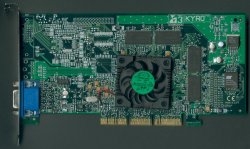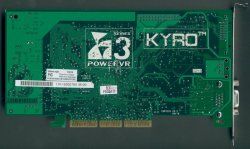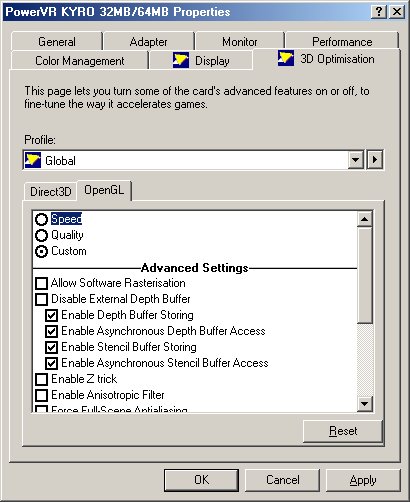Videologic KYRO Vivid Specifications
Listed below are the chip and board specifications:
-
115Mhz Core Clock speed
-
Dual Pixel Pipes / Single TMU Per Pipe
-
128Bit Memory bus
-
32MB SDRAM @ 115Mhz
-
AGP 2.0 Compliant, AGP4X/2X
-
.25um Silicon Process
-
~12 Million transistors
-
270Mhz RAMDAC
As we can see, with a core speed of 115Mhz, two pixel pipes and one TMU per pipe we only have a pixel/texel rate of 230Mpps/230Mtps, which on the face of it, in comparison to the Gigapixel monsters we are seeing these days, seems very, very low. It's actually below TNT2 level. However, remember that with the PowerVR rendering architecture we are only rendering the visible pixels - if that magic '3.5 times overdraw' number that I mentioned before comes into play, this chip should perform more like a 800+Mega Pixel card.
- 2 trilinear pixels per clock
- 8-layer multi-texturing support
- Internal True Colour 32-bit ARGB internal rendering and layer blending
- 32-bit Z/stencil buffer
- Direct3D environmental bump mapping (EMBM)
- RGB Gouraud shading and specular highlights
- bilinear, trilinear and anisotropic texture filtering
- colour key and alpha blended textures
- table and vertex fog
- texture compression (S3TC/DXTC)
- Full Scene Anti-Aliasing
- DirectX flexible vertex format support
- full range of OpenGL and Direct3D blend modes
- 128-bit GUI accelerator with 3 operand ROPs, hardware clipping, colour expansion, transparent BitBLT and stretch BitBLT.
- Video playback and MPEG2 decode acceleration with motion compensation
A Few notes on those specifications:
The stencil buffer is in fact 4 bits only. Also, although S3TC/DXTC is supported, only DXT1 mode is actually available; DXT1 is the most commonly used format however.
Package And Drivers
I received the board in, what appears to be, the full retail packaging. The box itself, with its 'uncluttered' approach struck me as reminiscent of the type of packaging that 3dfx would produce, albeit without the distinctive 'face' artwork.
The contents of the packaging included the Vivid! board itself, a driver CD, with printed installation instructions in the insert, a CD with the full WinDVD 2000 software, and an 'E-Color' colour key for monitor adjustment.
The contents of the driver CD, I thought, are fairly impressively presented; other vendors should take note. The CD autoruns into your web browser, and presents you with a number of options very clearly. It includes the Vivid! drivers (Version V1.0.4.44), some Kryo tech demos ('Fortune' fillrate test, 'House' 8 layer texturing demo, 'Dragonfly' Motion Blur demo, 'Scanner' showing modifier effects using volumes, 'Wheel' displaying EMBM, 'Vase' showing multitexture blending, and 'Village Mark' designed to show the performance benefits of the PowerVR rendering architecture), several game demos (SWAT3, Rollcage Stage II, Tomb Raider: The Last Revelation, Urban Chaos, Fifa 2000, Tony Hawk's Pro Skater 2), the E-Color software, and even some OpenGL screensavers.
The 3D configuration/options of the drivers are very plainly laid out and simple to use, again other vendors should take note (*cough* NVIDIA *cough*).
Videologic should also be commended for adding a very handy little feature into the driver control panel, a 'profile' selector for the 3D configurations. Selecting an executable and assigning a configuration can launch any game with your own specified settings. Very useful, and neatly done.
My only gripe with the 3D control panel is the options are hardly documented at all; there is minimal help available for them.



